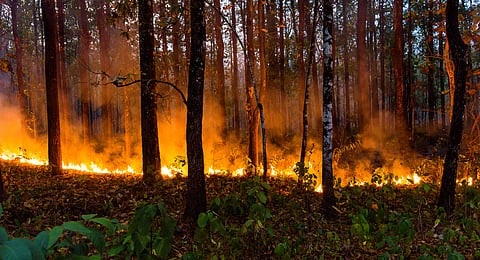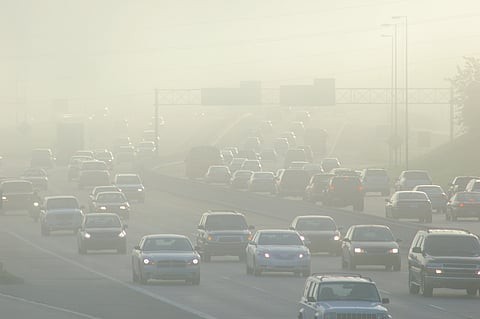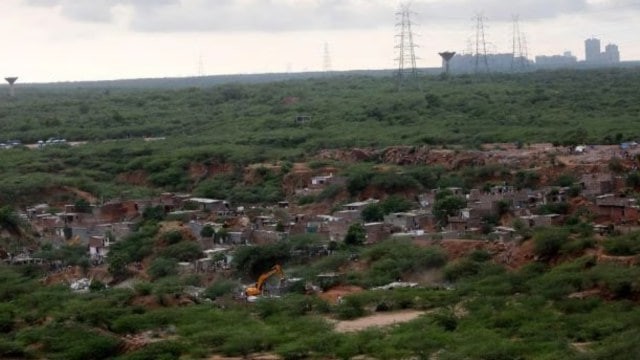Description
Copyright infringement not intended
Picture Courtesy: Down to Earth
Context:
In 2024, global tree cover loss reached unprecedented levels, with tropical primary forests experiencing a 370% increase in fire-related destruction compared to 2023. Overall, 29.6 million hectares of forest were lost worldwide, marking the second-highest annual loss on record.
Current Status:
- United States: California fires in January burned over 57,000 acres, causing an estimated $250 billion in damages.
- Asia: Japan lost 370 hectares and South Korea 48,000 hectares to wildfires in March.
- Canada: Early-season fires in May burned 58 million hectares, one of the largest on record.
- European Union: By August, wildfires affected over 1 million hectares, the largest EU wildfire season to date.
- According to the Global Forest Watch (GFW), India has lost 31 million hectares of tree cover since 2001, and in 2024 alone lost 18,200 hectares of primary forest (up from 17,700 hectares in 2023).
Multi-dimensional Implications:
Environmental & Climate Impact
- Carbon Emissions: Loss of dense forests and primary tree cover releases stored carbon into the atmosphere, undermining India’s climate mitigation efforts.
- GFW data indicates ~348,000 ha humid primary forest lost since 2002, reducing carbon sequestration potential.
- Wildfire Risk: Climate change and degradation increase forest vulnerability to fires, creating a feedback loop of emissions and further warming.
- Biodiversity Threats: Dense forests harbor endangered species; degradation can accelerate species loss, affecting ecosystems.
- India hosts 8.1% of global biodiversity; fragmented forests threaten endemic species.
Socio-Economic Impact
- Livelihoods: Millions of forest-dependent communities (tribals, forest dwellers) rely on forests for food, fuel, and employment. Loss of forest quality directly impacts income and sustenance.
- Agriculture & Water: Forest degradation reduces groundwater recharge and increases soil erosion, affecting agricultural productivity and food security.
- Urban Risks: Deforestation in peri-urban areas worsens flooding, heat waves, and air pollution.
Economic & Development Implications
- Tourism Loss: Wildlife sanctuaries, national parks, and ecotourism sites lose appeal when forests degrade.
- Carbon Markets & Green Finance: Reduced Forest carbon stock diminishes India’s potential to attract climate finance through carbon trading or offset schemes.
- Fire & Disaster Costs: 2024–25 saw major wildfires in Himachal Pradesh, Uttarakhand, and Northeast India. Economic damages include firefighting costs, loss of timber, and insurance claims.
Policy & Governance Implications
- Monitoring Gaps: ISFR reports gains in tree cover, but primary forest and dense forest losses indicate quality vs. quantity discrepancy.
- Regional Disparities: North-East states report significant losses; tailored policies needed per region.
- Need for Integrated Management: Reports suggest stronger coordination between forest department, climate policy bodies, and disaster management authorities to tackle forest fires, deforestation, and degradation simultaneously.
Challenges:
- Environmental Challenges: Increasing frequency and intensity of wildfires, degradation of primary and tropical forests, and heightened vulnerability to climate change impacts such as droughts and heatwaves.
- Biodiversity Loss: Rapid decline in wildlife populations, habitat fragmentation, and disruption of ecosystems that support both flora and fauna.
- Socio-Economic Challenges: Threats to forest-dependent communities, reduced agricultural productivity, and impacts on urban areas from increased air pollution and heat.
- Governance and Policy Gaps: Inadequate monitoring systems, fragmented institutional coordination, and weak enforcement of forest protection laws.
- Financial and Economic Constraints: Rising costs due to wildfire damage, insufficient climate finance for restoration and mitigation, and lack of incentives for community-based conservation initiatives.
Government Measures:
- The Forest Fire Prevention & Management Scheme (FFPMS) provides central funding to states for activities such as creating fire‑lines, water conservation in forests, procuring firefighting equipment, and community awareness.
- Under the National Action Plan on Forest Fires (NAPFF) 2018, the government mandates state action plans tailored to local fire‑risk zones and fosters coordination among forest departments and disaster‑management bodies.
- Technological interventions: The Forest Survey of India (FSI) uses satellite sensors (e.g., MODIS and SNPP‑VIIRS) for near‑real‑time fire alerts; development of GIS/remote‑sensing based monitoring systems is underway.
- Fire‑lines: States have dug new fire‑break lines (for example 15,700 km in certain zones) to stop spread of forest fires.
- Multi‑departmental guidelines: The central ministry has allowed non‑forest departments to carry out disaster prevention work in forest areas — especially where forest departments lack capacity.
- Community participation: Initiatives encourage local communities, forest fringe dwellers and JFMCs (Joint Forest Management Committees) to participate in fire prevention, early detection and forest restoration.
- Legal protections: Acts like the Forest (Conservation) Act, 1980 restrict deforestation and conversion of forest land, bolstering conservation efforts.
Way Forward:
- Enhanced Monitoring and Early Warning: Strengthen satellite-based forest fire detection, integrate AI-driven predictive models, and set up regional early warning systems to respond rapidly to fire outbreaks.
- Community Participation and Awareness: Engage local communities, forest dwellers, and Joint Forest Management Committees in fire prevention, controlled burns, and post-fire restoration activities. Conduct awareness campaigns on fire risks and climate change impacts.
- Capacity Building and Infrastructure: Train Forest officials, equip teams with modern firefighting tools, and establish quick-response units. Develop dedicated firebreaks, water storage systems, and fire-resistant plantation techniques.
- Policy Integration and Coordination: Mainstream Forest fire management into national and state disaster management plans. Ensure coordination between agencies like MoEFCC, state forest departments, and disaster response forces for unified action.
- Sustainable Land Use and Incentives: Encourage afforestation, agroforestry, and climate-resilient agriculture. Provide incentives for practices that reduce human-induced fire risks, such as regulated grazing, crop residue management, and conservation agriculture.
- Research, Technology, and Innovation: Invest in research on fire-resistant tree species, ecological restoration, and climate adaptation strategies. Promote technology-driven solutions like drones for monitoring and GIS-based fire mapping.
- Climate Mitigation and Adaptation Linkages: Integrate fire management into broader climate action strategies, recognizing its role in carbon emissions, biodiversity loss, and ecosystem degradation.
Conclusion:
Forest fires in India and globally are both a consequence and driver of climate change, causing severe environmental, economic, and social impacts. While India has made progress through policy measures, forest management programs, and early warning systems, challenges such as climate variability, human-induced fires, and biodiversity loss persist. A multi-pronged approach—combining technology, community participation, policy integration, and sustainable land use—is essential to mitigate fire risks, protect ecosystems, and enhance climate resilience. Proactive and coordinated action today will safeguard forests, livelihoods, and biodiversity for future generations.
Source: Down to Earth
|
Practice Question
Q. Forest fires not only threaten biodiversity but also affect agriculture, water resources, and human health. Discuss the multi-dimensional implications and suggest integrated solutions. (250 words)
|
Frequently Asked Questions (FAQs)
Forest fires are uncontrolled fires that burn in forests, grasslands, or wildlands, causing damage to vegetation, wildlife, and human settlements.
Causes include natural factors like lightning and dry conditions, and human activities such as negligence, slash-and-burn agriculture, and land clearing.
They lead to tree cover loss, release huge amounts of carbon dioxide, destroy habitats, reduce biodiversity, and worsen soil quality.











